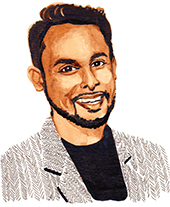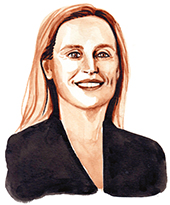
Dolly Chugh Associate Professor, Management and Organizations, Stern School of Business, New York University; author, The Person You Mean to Be: How Good People Fight Bias (HarperBusiness, 2018)
ONE CONCEPT THAT I DISCUSS in my work is ‘ordinary privilege’. Think about an aspect of your identity that you rarely have to think about. For example, as a straight woman, I can go for months without ever thinking about that, because I am not discriminated against or put in danger due to homophobia and bigotry. I chat freely about my husband at work, my medical benefits are never in question, and being legally married was never something I had to fight for.
That part of your identity is what I call ordinary privilege, and we can extrapolate this to different contexts. It could be that you are a native speaker of the language spoken in your environment; that you’re white in an environment where that is the norm; or that you are physically able to do things that some people aren’t. I can list a dozen aspects of my identity that I never have to think about; as well as others — like my religion, skin colour and gender — that I do need to think about often, both in my community and workplace.
Here’s an analogy that I learned from the work of racial justice educator Debby Irving: When I go jogging, every now and then I get a nice tailwind, and for a few minutes, I feel like an Olympic athlete — not realizing that the tailwind is doing most of the work; but when I head back towards home, all of a sudden that wind becomes a headwind, and I struggle. Now I notice the wind. The key is, wherever you have ‘tailwinds’ in your life, many other people are experiencing headwinds, and you are less likely to notice it because that’s the part of your identity you don’t think about.
There is good news about ordinary privilege: The areas of your identity that you think about the least — where you have the tailwinds in your favour — are also the area where you can have surprising influence. Research shows, for example, that if someone tells a racist joke and a black person speaks up about it, they are viewed more negatively than if a white person speaks up. In a career context, if a white manager hires a white person or a black person, they will not take a hit for that in the eyes of their manager; but if a black person hires a black person, they will take a hit for it.
Ordinary privilege is a surprising source of influence. Of course, we need to be careful not to speak over or for those who we wish to support. But we also need to be careful to not be bystanders and leave the work of fighting tailwinds to the people facing them.
 Jeewan Chanicka
Jeewan Chanicka
Superintendent, Equity, Anti-Racism and Anti-Oppression, Toronto District School Board
AS WE EXAMINE OUR BEHAVIOUR as a society, it is important to remember that through the colonization of Turtle Island [North America], systems and structures have been created to explicitly privilege certain people. Back when our current legislation was created, people believed, for instance, that women were inferior to men; that minorities and people with disabilities were inferior; that black people were tools for the economic benefit of those in power; that 2SLGBTQ+ identified people were deviant; and that Indigenous people needed to be civilized by being sent to residential schools. All of these things were coded into the law, and these laws have influenced the systems and structures that we are navigating today.
When we talk about the ‘hetero-normative views’ that exist today and the mindsets that propel them, we must remember that those mindsets weren’t chosen by people: They have been upheld by actual systems and structures for well over a hundred years. The laws and systems that guide us today are not neutral; they are artefacts of attitudes and beliefs.
This is not about shame, blame or guilt; it is about improving outcomes for all. One thing I work on with educators is to help them understand that when it comes to closing achievement/well-being gaps, raising the bar of excellence for all and fighting discrimination, there is no such thing as being ‘neutral’. In our work we must adopt an anti-oppressive stance, which begins by thinking about who we are in relation to who we are serving and what types of beliefs and attitudes transcend our spaces by virtue of the way structures have been created.
The fact is, if we are not actively addressing the fact that we are all products of these structures, then we are perpetuating them. Even though we all share the same world, we do not share the same experiences of it. If we want to reach higher levels of excellence and improve outcomes, we must remember that equity is a leadership competency, and build that into all of our systems and structures — both public and private.
 Alice Eagly
Alice Eagly
Professor of Psychology, Management and Organizations, Northwestern University
STEREOTYPES ARE NOT JUST MYTHS. They are grounded in everyday experience, and they tend to take on a life of their own. If you think about a particular group in a certain way, it affects your behaviour towards them. The roles we play in life also influence stereotypes. Throughout the day, most people move between their family role and their employment role, and in general, men and women are thought to have different traits as a result of these roles.
It is true that in the workplace, gender segregation has decreased over time, but it is still substantial. For one thing, we still see plenty of vertical segregation — a concentration of men in the most powerful and highest-paying roles—and there is also considerable horizontal segregation. That is, men and women occupy
roles that require different kinds of physical and psychological attributes: Men tend to be in jobs favouring physical strength, robustness and interaction with ‘things’ — jobs requiring analytical, mathematical and technical skills, and being competitive is often part of the mandate. Meanwhile, women are concentrated in jobs
requiring social interactional skills and offering opportunities for social contribution — jobs where you directly help others, like social work, nursing and teaching.
Segregation also occurs within occupations. People might point out that ‘there are plenty of female physicians and lawyers’, but the fact is, female physicians are concentrated in specialties like pediatrics, family practice, gynecology and psychiatry — the most socially-demanding work; and if you look at lawyers, lots of women work in public interest law and family law.
There is still a belief that women are less assertive and competitive than men, and this places women at a disadvantage for leadership roles. Because such ‘agentic behaviour’ is often disapproved in women, they experience backlash, which is half of what I call the ‘double bind’ for female leaders. The other half comes from the belief that women should be selfless and modest, but that such individuals are also weak and lack agency.
One solution to these problems is that women ought to ‘lean in’ more. Sheryl Sandberg’s book on the topic sold over four million copies, but the reaction to it in the feminist community has been quite negative. Many feminists feel, ‘We don’t need to be fixed!’ But in my view, to achieve equality in leadership, women do need to become more agentic — despite the possibility of backlash. If more women take that message seriously and act on it, we will achieve gender parity faster.
 Rony Hacohe
Rony Hacohe
Advisor, UK Behavioural Insights Team
AT THE HEART OF OUR WORK is improving the evidence base around ‘what works’ in terms of increasing gender equality in the workplace, and supporting employers to try approaches that have promise. We have taken on three concrete challenges. The first is that the public doesn’t quite ‘get’ the gender pay gap yet, and that is important because we need to start holding companies accountable. Two thirds of people still think the ‘gender pay gap’ and ‘equal pay’ are the same thing, but they are not. Equal pay is about paying people who do similar things differently, while the gender pay gap is about comparing the average hourly wage for men to that of women in an organization — and it is therefore more reflective of the overall power dynamics in an organization.
The second challenge we are working on is that while most employers are willing to submit their gender pay gap figures for public scrutiny, they aren’t sure where to begin in terms of making positive change. That’s not surprising, because many companies haven’t even looked at their data to understand precisely where the problems lie. As with any kind of behavioural change that you want to encourage, the key is to make it easy. So, to make it easy for employers we’ve published a clear guide [available at https://gender-pay-gap.service.gov.uk/public/assets/pdf/Evidence-based_actions_for_employers.pdf]. In the category of effective actions, it shows that most actions have to do with transparency, accountability and structure, because a lack of formal structure is how bias often creeps in. If there is a clear set of criteria and people must justify their decisions to someone, that is a great way to stop bias in its tracks.
The third challenge we are working on is that the evidence around ‘what works’ is patchy. To address this, we have been partnering with several large organizations to run our own field trials to improve the evidence base. We look at participating organizations’ recruitment data, performance evaluation data and promotion data, and wherever we find the most biases, we work with the company to create an intervention. The good news is, the demand to participate in these creative interventions has exceeded our expectations. More good news: People from every country in the world (except North Korea) have visited the Government Equalities Office’s gender pay gap website [https://gender-pay-gap.service.gov.uk/Viewing/search-results] to review the latest data, and many countries are considering introducing similar legislation.
 Humberto Carolo
Humberto Carolo
Executive Director, The White Ribbon Campaign
PART OF OUR WORK INVOLVES LOOKING at the root causes of violence against women. We believe that masculinity is socially constructed, so we have been studying how, from a very young age, boys and young men are pressured to conform to the popular notions of being a ‘real man’ — including dominance, control and anger as the only form of emotion that men are allowed to express (because anything else is a sign of weakness). We talk to young men about how these constructs affect their lives and the lives of others — particularly women and the LGBTQ communities — and we talk about the importance of promoting healthy, alternative forms of masculinity. As a society, we need to start encouraging men to live much healthier, more humane and empathetic lives, both for themselves and for everyone around them.
We have also done some research into men’s engagement in the #MeToo movement, whose conversations men have been mostly absent from. We invited 2,000 men to participate in a Campaign for Consent and Healthy Relationships, and as part of that research we asked them whether they had concerns about their own past behaviour towards women. We weren’t surprised to find that 61 per cent of participants said they had concerns. Couple that with the recent findings from GQ magazine, which polled 1,000 men between 18 and 55 and found that 47 per cent of them had never talked about the #MeToo movement with anyone. When you combine these two stats, one of the conclusions we should consider is that many men are not coming forward or participating in these conversations because they fear that what they have done in the past will come back to haunt them, and that they might be called to task if they speak publicly.
These are just a few of the issues we face in addressing issues of masculinity. The work we do is about encouraging men to think about the actions they can take to promote positive values and to think about their own behaviour, actions and language as a starting point to becoming change agents in their own sphere of life.
 Iris Bohnet
Iris Bohnet
Albert Pratt Professor of Business and Government and Academic Dean of the Harvard Kennedy School; author, What Works: Gender Equality By Design (Harvard University Press, 2016)
THE GOAL IS NOT TO change peoples’ mindsets; it is to make it easy for them to get things right by redesigning the world we live in. For example, in most hotel rooms, you might have noticed that the latest front-door entry cards do not only control access to the room; they also turn off the lights when you leave. This is an example of an effective way to make it really easy for people to do what is right for the environment — and all it takes is a bit of design and a bit of technology. Unfortunately, behavioural design with respect to diversity and inclusion has not reached this stage yet, but that is the goal.
In terms of using behavioural insights to influence consumer behaviour, many companies are already doing this. For example, Coca-Cola has gendered versions of its products. A few years ago, it realized that men were not buying Diet Coke. They did some research and found that ‘diet’ is not a word that resonates with men; so, they introduced Coke Zero to appeal to health-conscious males. As this example indicates, we are using more behavioural-insights rigour in our marketing departments than in our HR departments. I am on a mission to ensure that we use the same kind of tools and analytics to inform practices and procedures throughout organizations.
We now have data analysis and algorithms that can help to predict how certain adjectives in a job posting can increase or decrease the chances that women or men will apply for a particular job. If you can reach not just 50 per cent but 100 per cent of the talent pool with carefully chosen language, that is an example of a simple and cost-effective thing to focus on. There are start-ups out there working to develop these tools. They are still a work in progress, but they will very likely become widely available in the next five to 10 years. 
To learn more about the Behavioural Approaches to Diversity conference, please visit: www.badconference.com.
This article appeared in the Spring 2019 issue. Published by the University of Toronto’s Rotman School of Management, Rotman Management explores themes of interest to leaders, innovators and entrepreneurs.
Share this article: